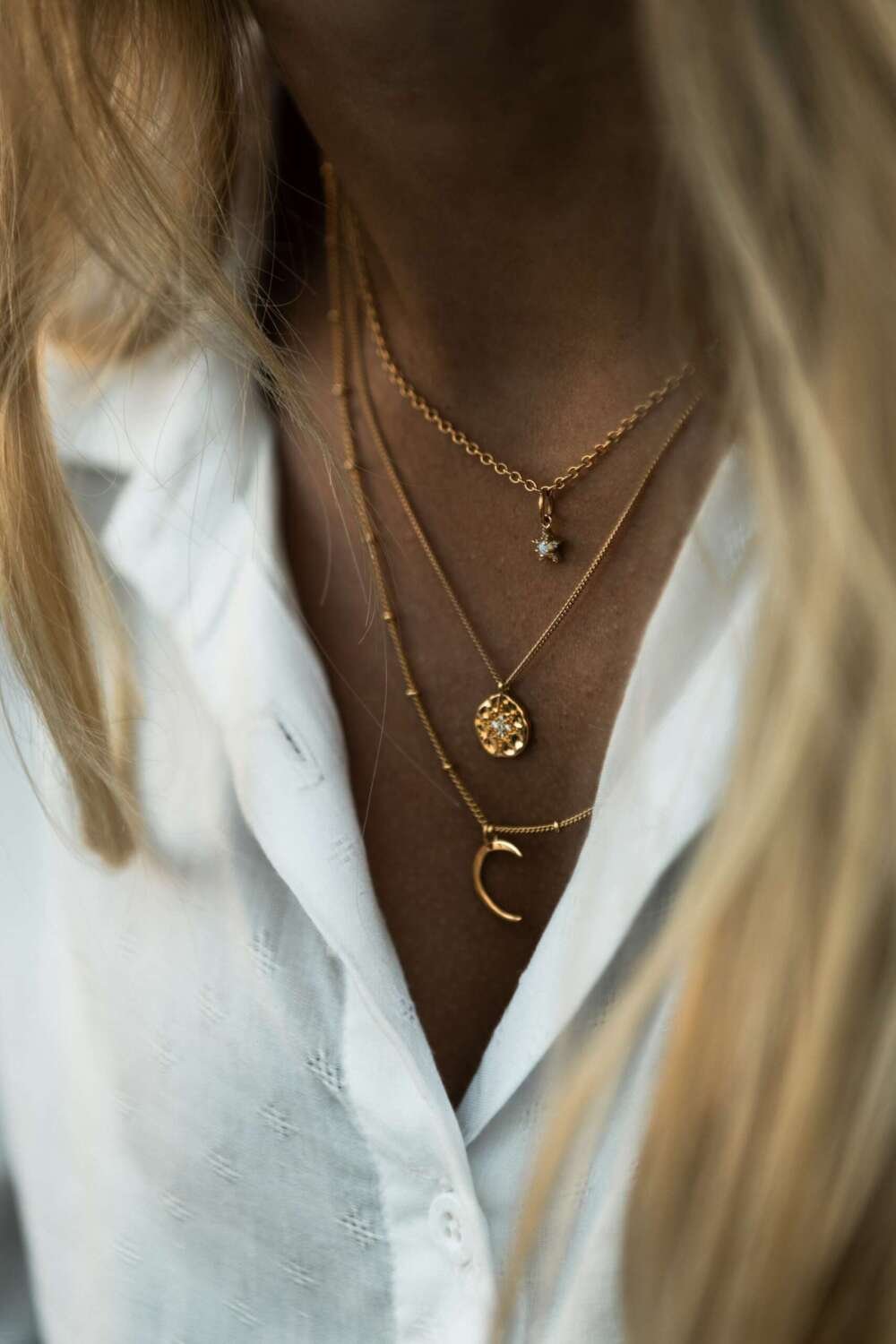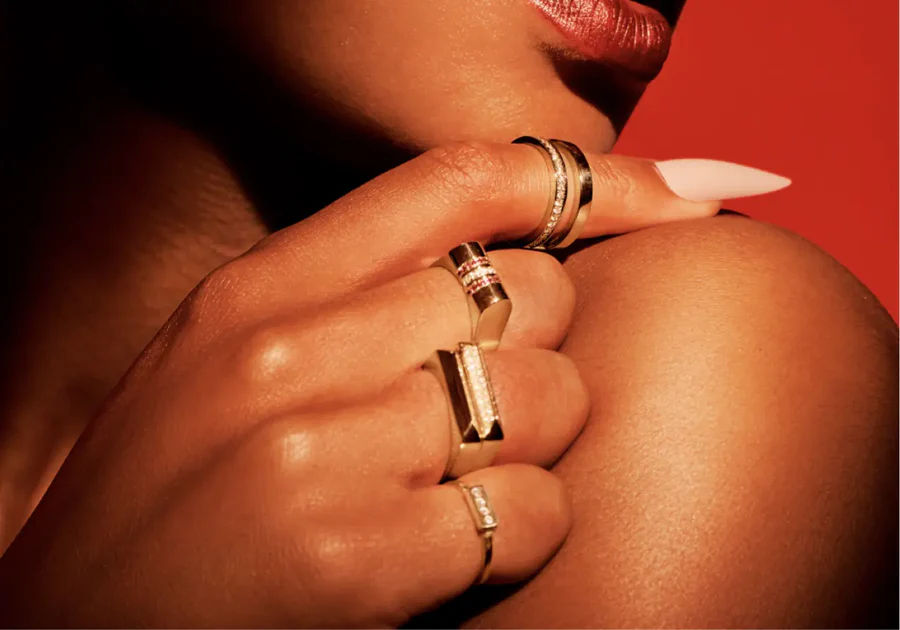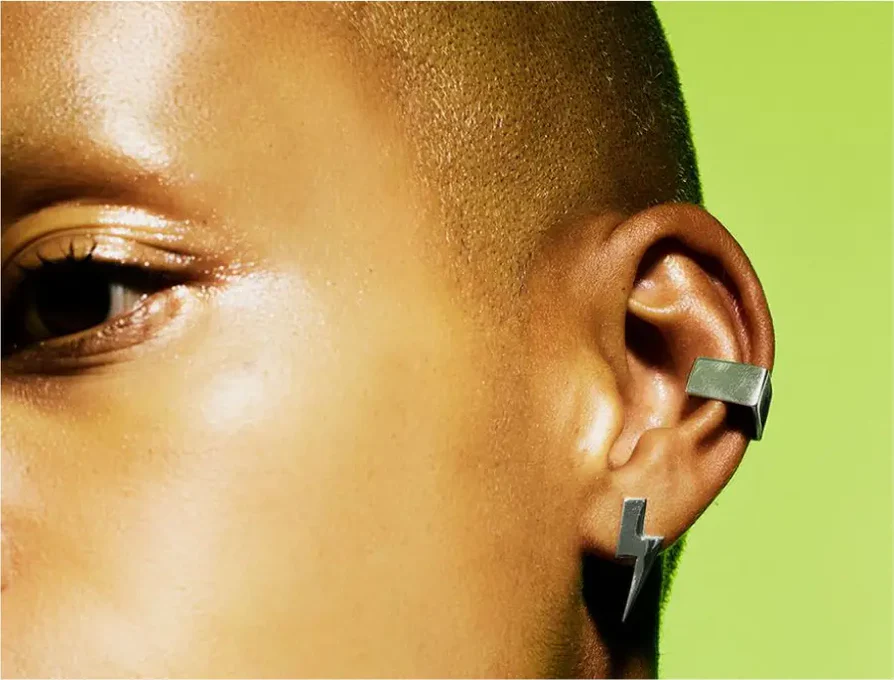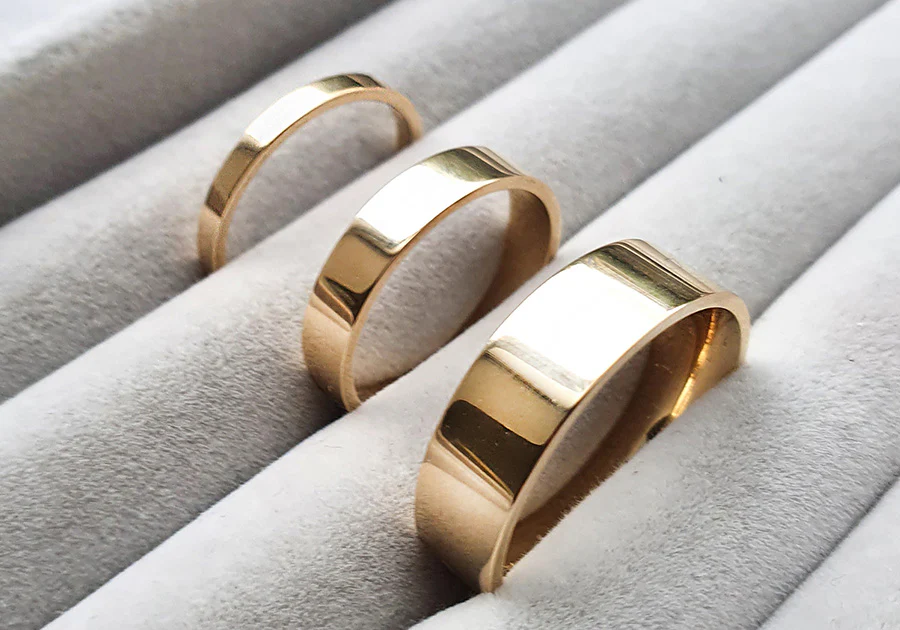Rethinking Jewelry: In Conversation With Edge Only

Share This Article
| All products featured on The Wellness Feed are independently selected by our editors for its environmental and ethical impact. However, when you buy something through our retail links, we may earn an affiliate commission. |
Months ago I wrote a round-up of sustainable men’s jewelry brands. I, like many men, had been captivated by Connell’s chain from Normal People (you can read a great explainer about this cultural moment here). Naturally, I started wearing a chain everyday. And after several months, I wanted to start digging deeper into the world of sustainable and ethical jewelry.
One brand I’ve kept my eye on since starting to learn more about sustainable jewelry is Edge Only, who sells bold, eye-catching designs for, well, everyone. They sell many of the same designs in both men’s and women’s sections and constantly work to expand their offerings to fit into niches like more masculine, industrial styles for women-the kind of thing founder Jenny Huston likes to wear; everyday jewelry for men; and elegant, stylish engagement bands.
I was lucky enough to sit down with Jenny Huston a few weeks ago and talk about the ongoing conversations around labor rights, sustainability, and gender within the jewelry industry, as well as how she addresses these topics. Near the end of the interview, Jenny said something that really encapsulates why I wanted to speak to her in the first place. “The goal is never to be a giant. The goal is just to have employees that like what they do and earn a decent wage and give products to people that put a smile on their face and make them feel more confident.” This is the ethos of Edge Only and a guiding idea for our discussion on labor rights, sustainability, and gender within jewelry.
Addressing Labor Issues Within Jewelry

The jewelry industry has a storied history with labor issues. You’ve probably heard of blood diamonds–gems that are wrapped up in violent conflicts–but it doesn’t end there. The Human Rights Watch has kept a close eye on the industry and reported on child labor, practices within the supply chain, and even how the industry has handled the COVID-19 pandemic. Over the years, these reports have consistently highlighted that miners, smiths, and other industry workers face dangerous working conditions, low wages, and in some cases, fear of violence.
Garment Workers Are Still Fighting For $$$ Millions In Unpaid Wages
While these trends hold true, there has been some positive change. Jenny told me about groups like The Gemstones and Jewellery Community Platform, The Coloured Gemstone Working Group, and The Responsible Jewellery Council that are trying to resolve human rights and sustainability issues within mining and jewelry more broadly. They advocate for stricter regulations on wages, waste, and working conditions, as well as an overall oversight of the industry.
Making a big change within the industry, however, is challenging. As Jenny so succinctly put it, “you need clout to make real impactful change.” Only large brands with enough money can make big changes; brands like Tiffany, Cartier, and Bulgari, which Jenny refers to as “the big boys.” If these brands follow the recommendations from working groups, they can use their power to put pressure on their manufacturers to ensure that ethical practices are being used, that miners are being treated fairly, and that the conditions are as safe as possible.
And while more recent Human Rights Watch reports show that big brands have been taking progressive steps, it’s hard to know where that leaves smaller brands. Jenny very openly admits that Edge Only and other independent jewelry brands are limited in what they can achieve on a large scale. But that doesn’t mean they can’t make their own kind of change.
Edge Only’s approach to addressing labor rights issues is local and community-centered. Every piece of their jewelry is crafted by a local artisan in Ireland. Because of this, Edge Only is held to really high European standards surrounding wages, working conditions, and environmental responsibility. Maybe you’ve noticed how many of your favorite sustainable and ethical brands are European; it’s in part because of strict EU regulations.
Staying local also means that Jenny can collaborate and connect with her community in a meaningful way. In working with local artisans, Edge Only helps keep income within the community they live and work in. Plus, every artisan that partners with Edge Only is given a high degree of flexibility. They can pick the designs that they feel best suited for, enjoy the most, or find the most fulfilling. The artisans also get to set their own rates and hours. The end result is that these workers get to engage with their craft in a lucrative way while maintaining a level of autonomy and happiness.
Sourcing Sustainable and Ethical Materials

Another way for smaller brands like Edge Only to avoid the supply chain issues of traditional jewelry is to source sustainable and ethical materials. For metals and gems, you can source Fair Trade certified materials. Fair Trade ensures that ethical practices, like fair wages and safe working environments, are used to make and process materials.
In addition to Fair Trade, Edge Only sources sustainable metals, like recycled gold and silver. Using recycled materials helps avoid the human and environmental impacts of sourcing virgin materials. For industry insiders and consumers alike, recycled gold is a tried and true material; we’ve all heard of people melting down their gold before. This makes recycled gold a great, familiar option for independent brands to incorporate into their products.
Recycled silver, however, doesn’t always get the same attention. As Jenny told me, “with silver it’s interesting, ya know, with gold, I feel like everybody understands that people have been selling gold for years so there’s a lot of gold that goes back into recycling but less [people] do that with silver.” However, recycled silver is out there; and it comes from unlikely places. Much of the recycled silver–also called ecosilver–on the market comes from parts of old technology or medical equipment. Because this silver is only one part of a larger whole item, it has to be picked apart first, which in turn makes the process more time-intensive and expensive.
The Humanity Behind Our Clothes: Why Ethical Fashion Matters
One of the biggest hot topics within materials for jewelry is the issue of diamonds. Diamonds are a singular, luxurious gem that are sought after across the world. They’re also notorious for human rights violations. The disconnect between what role diamonds play for consumers and companies and how they affect workers is complicated.
In the past few years, there’s been a rise in more ethical and sustainable options for diamonds. There are certifications and regulations to oversee that diamonds are being mined fairly and ethically. Some companies have even started to create lab-grown diamonds to avoid the ethical problems with conventional diamonds. However, there’s an ongoing dialogue about how sustainable this option is, as lab-grown diamonds involve high amounts of energy.
With diamonds, it seems like there’s no right or wrong answer. So where does this leave businesses and designers? Jenny offers this piece of advice, “you have to listen and learn and be willing to adapt.” You can operate under the best practices possible and still be open to the idea that there are better practices out there too. For Edge Only, this means offering conventional and lab-grown diamonds that are carefully selected while understanding that as times change, so will their materials.
Rethinking Gender and Jewelry

Another large conversation within the jewelry world centers around gender. For Edge Only, men’s jewelry has been important from the beginning. But it hasn’t always been easy. As Jenny told me, “when I started doing men’s jewelry 6 years ago… people would laugh at me and say, ‘men’s jewelry, what do you mean?’ and I’d be like ‘what don’t I mean? It’s everything from cufflinks to necklaces and rings and earrings. They couldn’t even picture what men’s jewelry was.” While this was the case 6 years ago, things are definitely starting to shift.
It’s really exciting to see people like Paul Mescal popularize the simple chain necklace and Harry Styles become the poster child for bold, audacious jewelry. In essence, these men offer up new extremes of what men’s jewelry can look like. For a long time, men’s jewelry existed on a very different scale. There were really conventional pieces–like cufflinks and tie clips, that were meant for men in three-piece-suits–as well as anchors and crosses and other mild designs. Then there were hard, punk pieces. Jenny calls these two extremes “bankers and bikers”.
But with the rise of men’s jewelry, there are so many options that exist in the middle of those old extremes. Now all types of men can find wearable, comfortable, and interesting pieces with a great deal of personality. For me, this would be something like the (chain) or the (geometric ring), but there are plenty of other options available from Edge Only and other like-minded brands.
Another corner oft-forgotten corner of men’s jewelry is wedding bands. Whereas wedding rings have a lot of personality, many wedding bands are simple and indistinguishable from one another. But why can’t men’s wedding bands be more interesting? Edge Only happens to be one of a handful of sustainable brands working to answer that question with their line of bands. As Jenny told me, “we’re just trying to provide what was missing and sort of fill that gap.”
At the same time as this expansion in men’s jewelry, we’re seeing a movement toward gender neutral jewelry. This can mean jewelry that exists outside of the masculine/feminine divide, as well as the idea that traditionally masculine and feminine jewelry can be worn by anyone regardless of gender identity. Some brands have even dropped gender categories from their websites altogether to make their consumers more comfortable and to help their consumers rethink how they view gender and jewelry. But the move toward genderless jewelry takes shape in a variety of ways.
As Jenny told me, Edge Only has always kept gender neutrality in mind. Their pieces aren’t necessarily designed with gender in mind and as long as there’s interest, they’ll offer a design on both their men’s and women’s sections. As Jenny pointed out, “Ya know me wearing a ring if I’m wearing makeup and a dress and nail polish would look completely different than you wearing that ring…part of it is just how you style it.” So it’s not like these pieces are inherently masculine or feminine; they’re just tools to play around with gender and style.
Looking Toward the Future of Jewelry
In thinking through what’s happening within the jewelry world now, it’s really exciting to imagine what the future of jewelry could be. As the gender dynamics within jewelry shift, there’s a lot of interesting prospects on the horizon. We may see more jewelry brands expand their men’s selections.
While gender neutrality is on the rise, Jenny did mention to me that we may still have gendered categories for some time. In her own research about men’s jewelry, she’s found that many men still want to have a separate category to themselves so they know where to look and what to look for. Men’s jewelry is underrepresented and that may have to be resolved before we fully shift toward gender neutrality.
On the other hand, we are seeing a big push from younger people to remove jewelry from younger generations to redefine what gender is, what gender performance is, and how this all interacts with how people dress and style themselves. As the consultants at Matter of Form put in a recent piece on the future of jewelry, “instead of buying for special occasions, people of all genders are buying for themselves…this presents an opportunity for brands to target products at all types of individual as well as relationships or occasions.” Jenny predicts that in five or ten years, we might reach the point where we just have jewelry without any gendered categories at all.
And as for changes with sustainability and ethics in jewelry, this will take time and money. I mentioned above that there are working groups devoted to making progress and some big brands are joining in. With this in mind, there is hope for a more ethical and sustainable industry going forward. And it doesn’t hurt that consumers want to buy responsible jewelry; the Alliance for Responsible Mining recently surveyed just over 1,000 consumers and nearly half said they would choose responsible gold over anything else.
If you want to keep an eye on the future of the jewelry industry, take a look at what Jenny and other independent jewelry designers do. The higher-level, big change is certainly exciting, but it’s slow. When you look at small brands that are adaptable and always striving to be better you get to see a much quicker change.
So what’s next for Edge Only? Jenny hopes to open a few brick and mortar stores. She hopes that this will encourage people to rethink the way they see jewelry. In person it’s a lot easier to understand that these pieces are truly made for everyone, not just a particular gender. Jenny also hopes to continue collaborating with other brands, like she recently did in a Father’s Day set. Jenny, like many independent business owners, believes in the saying “a rising tide lifts all boats.” This idea isn’t new, but it’s useful to remember. Besides, there’s plenty of “new” already happening within the world of jewelry.
